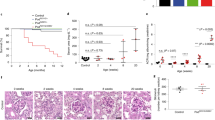Abstract
In this article, I shall outline some of the most important aspects of the evidentiary basis of the so-called Kriz model for the development of glomerular sclerosis, a model that we continue to modify to this day. In my mind, the most important findings include the fact that podocytes are generally post-mitotic cells, so that loss of a significant number for any cause leads to podocyte insufficiency. Another pivotal finding is that in many experimental models and in human disease, podocytes detach from the GBM as living cells. These facts, together with biomechanical deduction, have led to the ongoing evolution of the original Heidelberg model.
Similar content being viewed by others
References
Caulfield J, Reid J, Farquhar M (1976) Alterations of the glomerular epithelium in acute aminonucleoside nephrosis. Evidence for formation of occluding junctions and epithelial detachment. Lab Investig 34:43–59
Deen WM, Robertson CR, Brenner BM (1972) A model of glomerular ultrafiltration in the rat. Am J Phys 223:1178–1183
Endlich N, Endlich KH (2012) The challenge and response of podocytes to glomerular hypertension. Semin Nephrol 32:327–341
Friedrich C, Endlich N, Kriz W, Endlich K (2006) Podocytes are sensitive to fluid shear stress in vitro. Am J Physiol Renal Physiol 291:F856–F865
Fries JW, Sandstrom DJ, Meyer TW, Rennke HG (1989) Glomerular hypertrophy and epithelial cell injury modulate progressive glomerular sclerosis in the rat. Lab Investig 60:205–218
George B, Verma R, Soofi AA et al (2012) Crk1/2-dependent signaling is necessary for podocyte foot process spreading in mouse models of glomerular disease. J Clin Invest 122:674–692
Hara M, Yanagihara T, Takada T, Itoh M, Matsuno M, Yamamoto T, Kihara I (1998) Urinary excretion of podocytes reflects disease activity in children with glomerulonephritis. Am J Nephrol 18:35–41
Hara M, Yanagihara T, Kihara I (2007) Cumulative excretion of urinary podocytes reflects disease progression in IgA nephropathy and Schönlein-Henoch purpura nephritis. Clin J Am Soc Nephrol 2:231–238
Huber TB, Benzing T (2005) The slit diaphragm: a signaling platform to regulate podocyte function. Curr Opin Nephrol Hypertens 14:211–216
Ingber DE, Wang N, Stamenovic D (2014) Tensegrity, cellular biophysics, and the mechanics of living systems. Rep Prog Phys 77:046603
Kriz W, Elger M, Lemley K, Sakai T (1990) Structure of the glomerular mesangium: A biomechanical interpretation. Kidney Int 38(Suppl 30):S2–S9
Kriz W, Elger M, Nagata M, Kretzler M, Uiker S, Koeppen-Hagemann I, Tenschert S, Lemley KV (1994) The role of podocytes in the development of glomerular sclerosis. Kidney Int 45(Suppl 42):S64–S72
Kriz W, Hackenthal E, Nobiling R, Sakai T, Elger M, Hähnel B (1994) A role for podocytes to counteract capillary wall distension. Kidney Int 45:369–376
Kriz W, Elger M, Mundel P, Lemley KV (1995) Structure-stabilizing forces in the glomerular tuft. J Am Soc Nephrol 5:1731–1739
Kriz W, Hähnel B, Rösener S, Elger M (1995) Long-term treatment of rats with FGF-2 results in focal segmental glomerulosclerosis. Kidney Int 48:1435–1450
Kriz W, Kretzler M, Nagata M, Provoost AP, Shirato I, Uiker S, Sakai T, Lemley KV (1996) A frequent pathway to glomerulosclerosis: deterioration of tuft architecture—podocyte damage—segmental sclerosis. Kidney Blood Press Res 19:245–253
Kriz W, Gretz N, Lemley KV (1998) Progression of glomerular diseases: is the podocyte the culprit? Kidney Int 54:687–697
Kriz W, Shirato I, Nagata M, LeHir M, Lemley KV (2013) The podocyte’s response to stress: the enigma of foot process effacement. Am J Physiol Renal Physiol 304:F333–F347
Kriz W, Lemley KV (2015) A potential role for mechanical forces in the detachment of podocytes and the progression of CKD. J Am Soc Nephrol 26:258–269
Kriz W, Lemley IV (2017) Mechanical challenges to the glomerular filtration barrier: adaptations and pathway to sclerosis. Pediatr Nephrol 32:405–417
Lemley KV, Elger M, Koeppen-Hagemann I, Kretzler M, Nagata M, Sakai T, Uiker S, Kriz W (1992) The glomerular mesangium: capillary support function and its failure under experimental conditions. Clin Investig 70:843–856
Lemley KV, Lafayette RA, Safai M, Derby G, Blouch KL, Myers BD (2002) Podocytopenia and disease severity in IgA nephropathy. Kidney Int 61:1475–1485
Lemley KV (2016) Glomerular pathology and the progression of chronic kidney disease. Am J Physiol Renal Physiol 310:F1385–F1388
Nagata M, Schärer K, Kriz W (1992) Glomerular damage after uninephrectomy in young rats. I. Hypertrophy and distortion of capillary architecture. Kidney Int 42:136–147
Nagata M, Kriz W (1992) Glomerular damage after uninephrectomy in young rats. II. Mechanical stress on podocytes as a pathway to sclerosis. Kidney Int 42:148–160
Nagata M, Yamaguchi Y, Komatsu Y, Ito K (1995) Mitosis and the presence of binucleate cells among glomerular podocytes in diseased human kidney. Nephron 70:68–71
Pabst R, Sterzel RB (1983) Cell renewal of glomerular cell types in normal rats. An autoradiographic analysis. Kidney Int 24:626–631
Racusen LC, Fivush RA, Andersson H, Gahl WA (1991) Culture of renal tubular cells from the urine of patients with nephropathic cystinosis. J Am Soc Nephrol 1:1028–1033
Riser BL, Cortes P, Zhao X, Bernstein J, Dumler F, Narins RG (1992) Intraglomerular pressure and mesangial stretching stimulate extracellular matrix formation in the rat. J Clin Invest 90:1932–1943
Tenschert S, Elger M, Lemley KV (1995) Glomerular hypertrophy after subtotal nephrectomy: relationship to early glomerular injury. Virchows Arch 426:509–517
Vogelmann SU, Nelson WJ, Myers BD, Lemley KV (2003) Urinary excretion of viable podocytes in health and renal disease. Am J Physiol Renal Physiol 285:F40–F48
Wharram BL, Goyal M, Wiggins JE, Sanden SK, Hussain S, Filipiak WE, Saunders TL, Dysko RC, Kohno K, Holzman LB, Wiggins RC (2005) Podocyte depletion causes glomerulosclerosis: diphtheria toxin-induced podocyte depletion in rats expressing human diphtheria toxin receptor transgene. J Am Soc Nephrol 16:2941–2952
Author information
Authors and Affiliations
Corresponding author
Additional information
This article is part of the special issue on Functional Anatomy of the Kidney in Health and Disease in Pflügers Archiv – European Journal of Physiology
Rights and permissions
About this article
Cite this article
Lemley, K.V. Mechanical challenges to the glomerulus and podocyte loss: evolution of a paradigm. Pflugers Arch - Eur J Physiol 469, 959–963 (2017). https://doi.org/10.1007/s00424-017-2012-0
Received:
Accepted:
Published:
Issue Date:
DOI: https://doi.org/10.1007/s00424-017-2012-0




